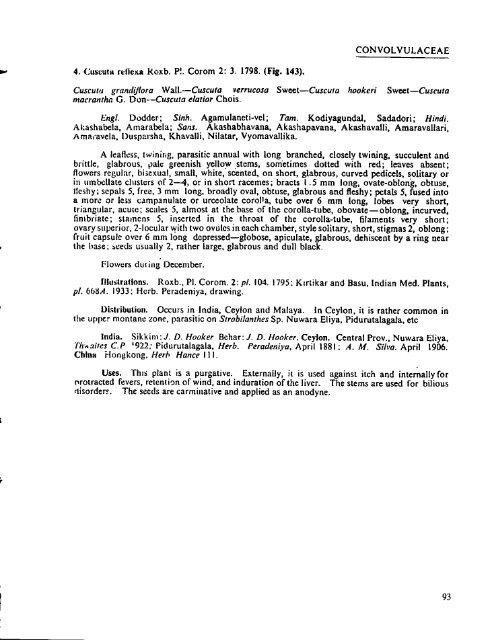,r\/*> - National Science Foundation
,r\/*> - National Science Foundation
,r\/*> - National Science Foundation
You also want an ePaper? Increase the reach of your titles
YUMPU automatically turns print PDFs into web optimized ePapers that Google loves.
4. Cuscuta rtflexa Roxb. P!. Corom 2: 3. 1798. (Fig. 143).<br />
CONVOLVULACEAE<br />
Cuscuta grandiflora Wall.—Cuscuta verrucosa Sweet—Cuscuta hookeri Sweet—Cuscuta<br />
macrantha G. Don—Cuscuta elatior Chois.<br />
Engl. Dodder; Sinh. Agamulancti-vcl; Tarn. Kodiyagundal, Sadadori; Hindi.<br />
Akashabela, Amarabela; Sans. Akashabhavana, Akashapavana, Akashavalli, Amaravallari,<br />
Amaiavela, Dusparsha, Khavalli, Nilatar, Vyomavallika.<br />
A leafless, twining, parasitic annual with long branched, closely twining, succulent and<br />
brittle, glabrous, pale greenish yellow stems, sometimes dotted with red; leaves absent;<br />
flowers regular, bisexual, small, white, scented, on short, glabrous, curved pedicels, solitary or<br />
in umbellate clusters of 2—4, or in short racemes; bracts 1.5 mm long, ovate-oblong, obtuse,<br />
fleshy; sepals 5, free, 3 mm long, broadly oval, obtuse, glabrous and fleshy; petals 5, fused into<br />
a more or less campanulate or urceolate corolla, tube over 6 mm long, lobes very short,<br />
triangular, acute; scales 5, almost at the base of the corolla-tube, obovate — oblong, incurved,<br />
fimbriate; stamens 5, inserted in the throat of the corolla-tube, filaments very short;<br />
ovary superior, 2-locuIar with two ovules in each chamber, style solitary, short, stigmas 2, oblong;<br />
fruit capsule over 6 mm long depressed—globose, apiculate, glabrous, dehiscent by a ring near<br />
the base; seeds usually 2, rather large, glabrous and dull black.<br />
Flowers during December.<br />
Illustrations. Roxb., PI. Corom. 2: pi. 104. 1795; Kirtikar and Basu, Indian Med. Plants,<br />
pi. 668/t. 1933: Herb. Peradeniya, drawing.<br />
Distribution. Occurs in India, Ceylon and Malaya. In Ceylon, it is rather common in<br />
the upper montane zone, parasitic on Strobilanthes Sp. Nuwara Eliya, Pidurutalagala, etc<br />
India. Sikkim:7. D. Hooker Behar:./. D. Hooker. Ceylon. Central Prov., Nuwara Eliya,<br />
Th*sites CP '922; Pidurutalagala, Herb. Peradeniya, April 1881; A. M. Silva. April 1906.<br />
China Hongkong, Herb Hance 111.<br />
Uses. This plant is a purgative. Externally, it is used against itch and internally for<br />
protracted fevers, retention of wind, and induration of the liver. The stems are used for bilious<br />
disorder-:. The seeds are carminative and applied as an anodyne.<br />
93
















